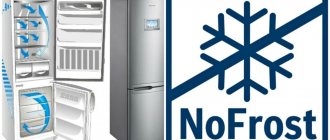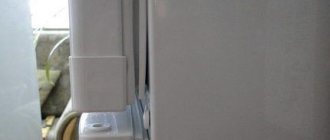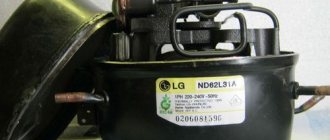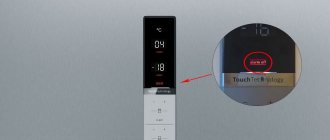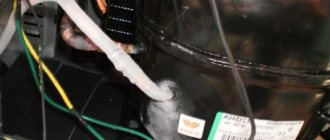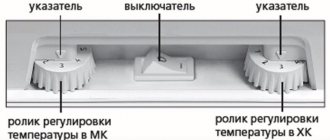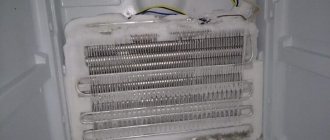Why does humidity appear in the refrigerator?
Regardless of the design of the refrigerator, excess humidity may appear in it if:
- open the door often or for a long time;
- place hot or uncovered food in it;
- do not remove a thick layer of ice from the inner surface of the chamber.
Dampness in the refrigerator can lead to the formation of mold on its walls and food, and the ice crust that builds up due to excess moisture creates additional stress on the motor.
In models with a drip system
In drip models, puddles most often appear on the bottom shelf under trays for storing vegetables and fruits. This mainly happens because the drain hole on the back wall is clogged. The humidity inside the chambers may also increase due to:
- blockage of the drainage tube;
- wear or damage to the rubber seal on the door;
- violations in the operation of the temperature sensor;
- improper placement of the refrigerator: if it is not level, the doors may be slightly skewed, letting air in.
If the blockage in the drainage hole is not removed in a timely manner, the water in it will become cloudy, an unpleasant musty smell will appear in the refrigerator compartment, and a “fur coat” of ice will form on the back wall.
In refrigerators with No Frost system
The No Frost system cools the contents of the chambers due to the movement of cold air, so water droplets practically do not form on the walls.
The need to clean the condensation in the “No Ice” refrigerator if it is used correctly occurs when the following breaks down:
- defrost sensor;
- electric heater;
- defrost timer.
Before looking for damage in one of the refrigerator components, you should check the fuses.
Even one burnt element can lead to the formation of high humidity.
Why does water collect in the refrigerator?
If you suddenly find water in the refrigerator, it is likely that there was a power outage while you were away from the kitchen.
The frost that had frozen on the walls of the device thawed and the liquid poured over the shelves, filling the trays and accumulating below. This situation does not require intervention in the operation of the unit. Simply collect the water and leave the refrigerator to continue running. If you are the happy owner of a No Frost system or frost simply does not accumulate in your device, the possible cause of a refrigerator leak lies in a clogged pipeline or drainage system through which melt water flows into a special tray under the compressor. Most often this happens either due to poor cleaning of the refrigerator, or if it has not been washed at all for a long time. Water flowing down the back wall takes with it grease, dirt or foreign objects that clog the hole, leading to the formation of mold in the tube and its clogging.
In this situation, firstly, wash the refrigerator well and wipe it dry or leave it to dry on its own. Next, in order to clean the tube, a regular medical blower will do. Fill it with hot water and, inserting the spout into the hole, press firmly. Pressurized water will help remove the blockage by draining all the dirt into a special tray on the back wall of the refrigerator, which will then need to be washed.
A possible reason for the appearance of water in the refrigerator is non-compliance with the rules for operating a crying evaporator. This part of the device provides for the separation of products at a certain distance. If you put food too close, the evaporator begins to “cry” with a vengeance, which leads to a leak in the refrigerator.
The drainage system is another possible source of the problem described. Due to the fact that some tubes in its composition have shifted, water can spill past, filling the shelves and trays below. Such a malfunction may require the attention of a technician, because even if you put everything in place yourself, after a while the problem will still happen again.
We also note the possibility of malfunction of the thermostat. Only a specialist can accurately determine this problem and fix it. Therefore, if the above recommendations did not help, start choosing a refrigerator repair shop, of which there are quite a lot today. The cost of calling a technician will depend on your region and the severity of the breakdown that he diagnoses.
To summarize, we note that the problem of water accumulation in the refrigerator leads not only to accelerated spoilage of food and the appearance of an unpleasant odor, but also to disruption of the operation of the device itself. Excessive amounts of liquid can seep into the gaps between the inner and outer walls of the device, leading to the onset of corrosion processes, which over time will cause serious damage. Take care of your refrigerator, keep it clean and then its service life will last year after year, without malfunctions and problems.
If you find a puddle on or near the bottom shelf of the refrigerator, serious damage may be the cause. It’s not always possible to solve the problem yourself, but you can always determine its source yourself. First you need to determine where and why the refrigerator is leaking.
If water is flowing inside the back wall of the refrigerator, then serious problems can be said with full confidence if it is equipped with the latest NoFrost technology. This system does not allow the formation of evaporation inside the refrigeration unit, which means that the occurrence of moisture is completely unacceptable. If your refrigerator does not use NoFrost, then the presence of water on the back wall may be quite normal.
Many refrigerator models have a system called a “crying” evaporator. Its characteristics are not inferior to new technological developments, but it costs much less. Why, then, does water accumulate inside the refrigerator on the back wall? The answer is simple - when the compressor is at rest, the ice melts. Often such models are equipped with drawers in which liquid accumulates so that it does not leak out.
If puddles form below, the cause may be a clogged special hole, which serves to collect water flowing from the walls. In this case, the water simply has no choice but to spread over the surface. It is quite possible to solve such a problem with your own hands; cleaning the hole will save you from the formation of puddles, both inside and below the refrigerator. The reasons why a refrigeration unit leaks can be even more trivial - a power outage, power problems.
What level of humidity is normal?
The normal level of humidity in a refrigerator depends on its type; this data is available in the instructions. You can determine the absence of dampness inside a device with any cooling system visually. If there is little ice in the chamber, the walls and shelves are dry, and drops of liquid appear on the back wall of the main compartment occasionally during defrosting, then the device is working correctly.
To avoid the need to remove moisture from the refrigerator, maintain an optimal microclimate inside it:
- place the contents at a distance from the walls of the chamber so as not to impede air circulation;
- do not pack shelves close to each other;
- do not put hot food inside;
- Be sure to close lids on containers and containers containing liquids or wet foods.
Devices with an electronic warning system will warn the owner of a violation of the humidity regime with light or sound signals.
On other models, the appearance of dampness must be monitored independently.
Ways to eliminate moisture
Sometimes all you need to do to get rid of humidity in a refrigerator with a drip system is to move the bottom fruit and vegetable trays a little. They should not touch the walls of the chamber.
If the cause of dampness is a clogged drain hole, then clean it with a special brush included in the kit or a medical bulb.
To remove condensation on the refrigerator partition, which has formed due to damage to the seal on the door, you need to replace it.
It is impossible to get rid of moisture in the refrigerator resulting from a broken temperature sensor on your own. You should call a technician who will replace the damaged part.
In refrigerators with a No Frost system, excess moisture can accumulate only due to damage to its components.
To get rid of moisture in the refrigerator, you need to identify the defective part and replace it. If you have no experience in repairing cooling equipment or household appliances, then it is better to entrust the matter to a specialist.
After the cause of condensation has been eliminated, clean the device from any remaining liquid and possible mold bacteria. This can be done both with ready-made drugs and using traditional methods.
Ready-made products
Store-bought preparations to eliminate the effects of excessive dampness contain aggressive chemical components, so you need to use them with rubber gloves.
After cleaning, wash the substance off the walls and shelves with soapy water, rinse the surfaces and ventilate the kitchen.
The best refrigerator disinfectants:
- “Silit Bang Black Mold Removal” - spray with active chlorine;
- "Penosaur Horse Cleaner for refrigerators" - foam for eliminating microorganisms and musty odors, safe for plastic, rubber and metal parts of the device;
- “Diabak” is a concentrated disinfectant for kitchen appliances and any household items;
- “Top House Refrigerator Cleaner” is a sprayer that cleans the internal walls of the appliance;
- “Bagi Anti-Mold” is an antibacterial spray that removes fungi and mold organisms.
Before you start cleaning the device, be sure to disconnect it from the power supply.
Traditional methods
Homemade refrigerator cleaning recipes:
- Hydrogen peroxide 3% works well against fungus and mold and disinfects device chambers, but due to its bleaching properties it is not recommended to use it on black or dark-colored parts.
- Any alcohol has a disinfectant and antifungal effect. Ammonia needs to be diluted 1:1, the rest can be used to immediately wipe the surfaces. After treatment, the refrigerator compartment does not need to be rinsed with water; it is enough to ventilate the compartment.
- Laundry soap and bleach contain alkali, which resists the formation of mildew.
- A solution of soda and vinegar helps get rid of mold and unpleasant odors in the refrigerator.
Before starting the procedure, make sure that condensation is formed within normal limits.
Finding and eliminating possible breakdowns
If all of the above methods do not bring results and condensation still forms, then the reason is damage to the device mechanism. Without experience in repairing refrigeration equipment, you should not look for and try to fix the breakdown; it is better to entrust this matter to a specialist.
In rare cases, condensation may appear due to improper assembly in production: the refrigerant circulation system touches the drain tube and freezing occurs. A repairman who will separate the parts will help you get rid of water in a refrigerator with a manufacturing defect. If the device is still under warranty, then you should contact an official service center.
Reasons for condensation in the refrigerator
If you have decided on the defrosting system, then you can start looking for the problem.
For drip-type refrigeration equipment
As already mentioned, condensation on the back wall of the refrigerator is normal. But if accumulations of water are observed in other places, you need to check the drainage system for blockages.
- The drainage chamber or tube is clogged. There is nowhere for moisture to drain from the wall, so it accumulates below. The causes of blockage are small crumbs and debris that fall with drops of water. As a result, the evaporator does not have time to thaw and becomes covered with snow. A cotton swab or other thin object will help remove the blockage. You can also use a syringe. Pour warm water into the drain compartment until it is flushed.
- Depressurization. Worn door rubber does not allow the chamber to be sealed. Warm air penetrates the compartment, and the refrigerator, compensating for the increase in temperature, works even harder. Then the seal needs to be urgently replaced. The door may not close properly due to improper installation of the equipment. If the body is tilted forward, the door opens randomly.
- Malfunction of the temperature sensor, which notifies the system about the temperature in the chamber. Incorrect operation leads to a decrease in the temperature in the chamber, the walls become covered with snow.
You can fix most problems yourself. But some need professional repairs.
For No Frost type refrigeration appliance
If condensation forms in the refrigerator “Atlant”, “Samsung” and other brands with the No Frost system, it means that there are problems in the defrost module. It consists of the following parts:
timer and defrost sensor;
- heater;
- fuse.
A breakdown can be determined by the following signs:
- the motor is constantly running and does not turn off to rest;
- The refrigerator compartment does not cool food, and the freezer compartment is covered with snow.
Since the temperature in the lower compartment is higher, the snow in the freezer melts a little and moisture flows down the walls. This results in condensation and puddles of water. Only replacing parts will help.
Watch the video on the topic:
As a result of the formation of moisture, food spoils faster and a specific smell appears in the chamber. Snow and ice on the walls contribute to the corrosion of metal elements of equipment, so do not delay repairs. If you cannot solve the problem yourself, contact the service center.
